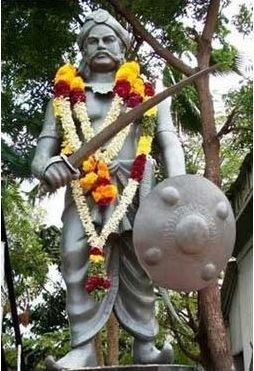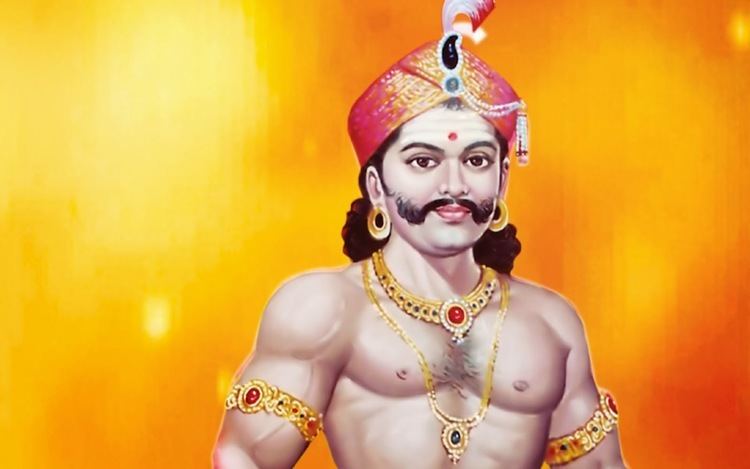Reign ?– 16 October 1755 Spouse Kayalkani Nachiyar Mother Sivagnanam Nachiyar | Father Chitraputra Thevar Religion Hinduism | |
 | ||
Parents Chitraputra Thevar, Sivagnanam Nachiyar Born 1 September 1715, Nerkattumseval, Madurai Nayak kingdom (Modern Day Tenkasi, Tamil Nadu, India) Died c. 1767 (aged 42), Tenkasi, Arcot (Modern Day Tamil Nadu, India) Similar Ondiveeran, Veerapandiya Kattabomman, Dheeran Chinnamalai | ||
Puli thevar history
Puli Thevar was a poligar (palayakarar) who ruled Nerkattumseval situated in the Sankarankoil taluk, Tirunelveli Tamil Nadu.
Contents
- Puli thevar history
- Puli thevar history indian freedom fighter s history
- History
- Puli Thevan War
- Western confederacy by Nel Kattum Sevval
- References
Puli thevar history indian freedom fighter s history
History

Puli Thevar was involved in a vendetta with the Nawab of Arcot who was supported by the British. Thevar's prominent exploits were his confrontations with Marudhanayagam, who later rebelled against the British in the late 1750s and early 1760s me.
Nelkatumseval was the headquarters of Puli Thevar.
The author of the Thirunelveli District Gazetteer, H.R. Pate, observes as follows:

Nelkatumseval is chiefly memorable as having been in the eighteenth Century stronghold of the redoubtable Puli Thevar, who figured for many years as the leader of the Marava Confederacy against the troops of the Nawab and the Company. He had a shrewd insight into the political situation of the time and was a veritable thorn against the side of the Nawab's agents.

Pulithevar remains one of the illustrious figures in the chequered history of palayakarars. The vivacity of his character gave him an ascendancy over the western palayakarars, while his determined resistance to the Nawab's overlordship made him a potential enemy of the Wallajahs. He was the principal architect of the coalition of the palayakkars organised against the Nawab. The Nawab acknowledged his victory by presenting him with a gold plate and sword.
Puli Thevan War

There were a number of revolts by local powers in the South, the first being as early as 1757. When Mohammed Ali, the Nawab of the Carnatic, supported by the Company, attempted to extend his control over the "Madurai" and "Thirunelveli" districts, the poligars rebelled. The western poligars, led by Puli Thevar of Nelkatumseval, forged individual alliances and then a grand alliance as they revolted against Mohammed Ali. Of necessity, Ali had to seek assistance from John Company, and, though battles were won and lost, the revolt was put down in 1761 by Yusuf Khan, who had been nominated the Governor of "Madurai" and "Thirunelveli" in 1758 by the British, despite Nawab Mohammed Ali's objections.
Western confederacy by Nel Kattum Sevval

"Nel kattum sevval" literally translates to "Rice tribute paying place", but after its ruler Puli Thevan's successful (initially) attempts at defying Mohammed Ali, the name changed to nel kattan sevval ("place which doesn't pay rice tribute"). These palayams declared their independence in 1757. Yusuf Khan, or Marudhanayagam, was sent by the British to bring the poligars under control and make them pay kisthi. Earlier campaigns in 1755 by Mahfuz Khan were unsuccessful in subduing the poligars' partly because of their sticking to each other and partly because British troops had to be withdrawn to raise the French siege of Madras (by Lally). Yusuf Khan effectively subdued the eastern poligars before turning his attention towards Pooli Thevan. This led to a succession of sieges on the forts under Pooli Thevan's control, culminating in the destruction of the Nerkattansevval fort by British artillery. Puli Thevan was apprehended but managed to escape while being transported for imprisonment. Subsequent to his capture and escape, there are no reliable historical records detailing his fate.
